Services on Demand
Journal
Article
Indicators
-
 Cited by SciELO
Cited by SciELO -
 Access statistics
Access statistics
Related links
-
 Cited by Google
Cited by Google -
 Similars in
SciELO
Similars in
SciELO -
 Similars in Google
Similars in Google
Share
Agronomía Colombiana
Print version ISSN 0120-9965
Agron. colomb. vol.33 no.1 Bogotá Jan./Apr. 2015
https://doi.org/10.15446/agron.colomb.v33n1.49369
Doi: 10.15446/agron.colomb.v33n1.49369
1 Department of Rural Development, Faculty of Agricultural Sciences, Universidad Nacional de Colombia. Bogota (Colombia). myhermosag@unal.edu.co
2 Purdue Extension's at Learning Network Clinton County, Purdue University. Frankfort (IN, US)
3 Child Development & Family Studies, College of Health & Human Science, Purdue University. Frankfort (IN, US)
Received for publication: 26 February, 2015. Accepted for publication: 30 March, 2015.
Abstract
Thirteen percent of the total population of the United States (US) is composed of immigrants. Mexicans accounted for about three-quarters of the increase in the Hispanic population from 2000 to 2010. The social and economic problems facing this population in their countries of origin are fueling migration to the US, in search of new opportunities. The purpose of this study was to identify and compare the changes in living conditions (housing, health, education) and the dietary intake (ex - ante and ex - post) of the Latino immigrant population that emigrated from rural areas in Mexico. The participants were attendees of the Purdue Extension Learning Network of Clinton County, who filled out a questionnaire with open and closed questions. The results evidenced the perception of improved quality of life variables related to housing, access to utilities and education, and a change with a tendency for increases in their consumption of fast food, processed food and soda, generating negative effects in terms of an increase in being overweight and obesity, and particularly a lowered consumption of products from their traditional diet.
Key words: quality of life, overweight, rural areas, consumption, fast food, income.
Resumen
El trece por ciento de la población total de los Estados Unidos son inmigrantes, la población mexicana representó alrededor de tres cuartas partes de los aumentos en la población hispana entre 2000 - 2010. Debido a los problemas sociales y económicos que enfrenta esta población en sus países de origen, se viene impulsando la migración a los Estados Unidos para la búsqueda de nuevas oportunidades. El propósito de este estudio fue identificar y comparar las percepciones de cambio en las condiciones de vida (vivienda, salud, educación) y de los hábitos alimenticios (ex - ante, ex - post) de los inmigrantes latinos provenientes de áreas rurales de México. Los participantes entrevistados asistían al centro de Aprendizaje de Purdue Extensión del condado de Clinton, a quienes se realizó una entrevista-cuestionario con preguntas abiertas y cerradas. Los resultados evidencian una percepción en el mejoramiento de la calidad de vida relacionado a las variables de vivienda, acceso a servicios y educación, y un cambio en los hábitos alimenticios con tendencia al incremento en el consumo de comidas rápidas, procesadas y sodas, generando efectos negativos en términos del incremento en el sobrepeso y obesidad, y de manera particular el menor consumo asociado a productos alimentarios relacionados a su dieta tradicional.
Palabras clave: calidad de vida, sobrepeso, áreas rurales, consumo, comida rápida, ingreso.
Introduction
Large numbers of people have been forced to migrate from their homeland because of different social and economic problems seen in their countries. The poverty gap in Mexico has reinforced the displacement of a large number of Mexicans from rural and indigenous areas to the United States or others places within this territory, in search of employment and better opportunities for improving their quality of life (Rojas, 2012). They migrate to other places in search of new opportunities for themselves and their families. The United States receives a large percentage of immigrant communities in the world, and the Mexican community represents one of the biggest, with 28.6% of the total Latino population (MPI, 2015).
Several studies conducted with the immigrant population have addressed several issues concerned with family, social, and economic aspects (Marroni, 2006; Domínguez and Polo, 2009; Salas et al., 2011; Ordoríca and Prud'Homme, 2012). As mentioned by other authors, immigrant agricultural workers belong to a sector of the population that is socially excluded, marked by poverty and ignored by social studies (Vera and Robles, 2010).
The aim of this study was concerned with perceptions of change regarding living conditions and diet for rural immigrants. The concept of living conditions is linked to the notion of quality of life and refers to both "objective" (e.g., housing conditions, crowding, employment) and "subjective" aspects (e.g., degree of perceived wellbeing, satisfaction of needs through social roles and affiliation (Palomba, 2002; Verbeke and Poquiviqui, 2005; Lafuente et al., 2009).
One of the key topics associated with quality of life is nutritional needs. Yet, nutrition must be achieved in a balanced way so that it does not affect individuals negatively. This dietary acculturation is a multidimensional change related to a variable dynamic and complex; in addition, it varies considerably, depending on a variety of personal, cultural, and environmental attributes (Satia-Abouta et al., 2002). The FAO (2009) reports that Mexican nutritional problems involve social and cultural roots. Although the average consumption levels indicated a sufficient intake of nutrients for the entire national population, a significant part came from an inadequate and repetitive diet, contributing to a rapidly growing number of people with obesity problems.
Major changes in diet that produce a nutritional impact as a result of changes in dietary patterns are correlated with economic, social, demographic and health factors as they start from the time of migration; this situation has been seen in mainly immigrant populations of ethnic groups, generating negative implications for health through a risk of chronic diseases: obesity, cardiovascular disease, diabetes, and hypertension, in ethnic populations (Gadd et al., 2005) and, particularly, immigrant populations (Gilbert and Khokhar, 2008).
The obesity risk increase was notable because these people have a reduced physical activity for two reasons: on the one hand, due to a reliance of these communities on an increased use of motorized transportation (Sallis and Glanz, 2009) and, moreover, the difficulty of accessing safe areas for convenient recreation or walking (French et al., 2001).
Furthermore, the main change in diet is evident by an increase in consumption of processed foods, rich in sugar, salt and fat, with a significant decrease in consumption of healthy foods such as fruits and vegetables (FAO, 2013). Consuming foods with these characteristics seems to be more attractive to the population due to the low cost, resulting in a situation that can be associated with the acculturation of diet and the low income level of the immigrant populations (Satia-Abouta et al., 2002). The US Department of Health and Human Services (USDHHS, (2005) indicated that obesity and being overweight prevail in households with a low income.
Frankfort is a small rural community located in Clinton County in the state of Indiana that has a 25% Latino population (United States Census Bureau, 2010). In addition, the FRAC (2010) reported that 25.3 percent of Hispanic or Latino households in the United States live below the poverty line. These reports can lead us to infer that a low income level is directly related to inadequate living conditions and nutrition habits that result in obesity and overweight problems.
Methods
This pilot study was developed in Frankfort, a small rural community located in the state of Indiana. For the study, the perception 20 Latino Immigrants from rural areas of Mexico with regard to their change in living conditions and dietary after immigrating were consulted. The socio-demographic information of the participants shows Tab. 1.
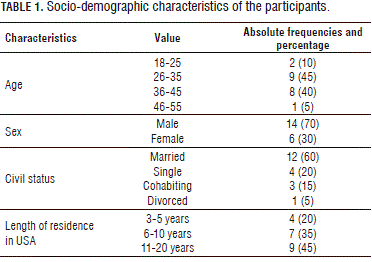
The recruitment of the participants was conducted at the Purdue Extension Learning Network of Clinton County. This center has a mission to increase the educational opportunities for residents, with the main objective of Latino community immigrants achieving greater integration in employment and improving their income and, therefore, their conditions of life. The participants came to the center while attending English classes during the time of this study, with a condition of being older than 18 for participation in this study and having lived in the US for more than one year, their participation was voluntary.
For collecting the information, a semi-structured interview was used, with open and closed questions, which sought to identify changes in their living conditions and diet between their country of origin and their current diet in the US. The topics evaluated in the interview are shown in Tab. 2.
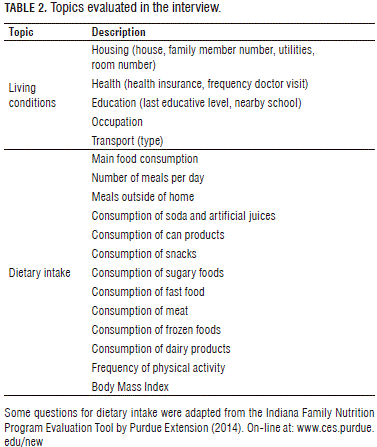
The last part of the interview aimed to have the participants rate their satisfaction with their degree of living conditions and diet to which they had access in their country of origin as compared to their overall access in the US after immigration; a scale of 1 to 7 was used to evaluate the change in the perception of this population, where: 1 - extremely dissatisfied, 2 - very dissatisfied, 3 - somewhat satisfied, 4 - neutral, 5 - satisfied, 6 - very satisfied, and 7 - extremely satisfied. Additionally, for each participant, the Body Mass Index (BMI) was measured, which relates weight to height; this index was obtained to identify obese and overweight participants.
The interview was conducted in their native language (Spanish) and was recorded in audiotape. The average duration for each interview was approximately one hour and 15 min. The interviews were done at the office of Learning Network of Clinton County. The audio of all of the interviews were transcribed and then organized by topic; the topics were: health education, transportation and diet. We used the thematic analysis method that describes patterns across the qualitative data and discovered themes and concepts embedded throughout the interviews (Braun and Clarke, 2006).
The encoded information was processed with the Statistical Package for Social Sciences (SPSS), with 95% confidence, where a paired t-test was performed to assess whether there were statistically significant differences in the variables evaluated by the participants with their responses to the interview. For the discussion of the results, an analysis of percentage and frequencies was used for the declarations of the immigrants consulted in relation to the selected variables for the perceived living conditions and dietary habits.
Results and discussion
Changes in living conditions
The results show statistically significant differences in the topics of housing and education. Table 3 shows the obtained data in detail.
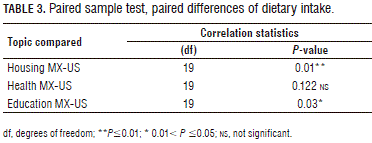
In the housing conditions, statistically significant differences were found with a value of 0.01 in Mexico, mainly because not all of the participants had access to gas service and potable water, whereas, in the United States, access were guaranteed for all of the participants. Another aspect influencing positive change for housing was that, in all of the households, the host country provided access to bathrooms, while, in Mexico, 40% of the homes of the participants did not have this. Other topics related to housing do not present changes in relation to the country of origin, such as home ownership and number of rooms.
In access to health conditions, significant differences were not found according to the participants' responses, who declared that they did not have health services in either country. For instance, in Mexico, the participants did not have information that allowed access to health insurance, while, in the United States, high costs and legal status are a restriction for health care access; therefore, the frequency of doctor visits did not have a significant difference. One third of immigrants in the US (33%) are uninsured, compared to 12% of American citizens (MPI, 2015).
In access to education, statistically significant differences were found. Eighty percent of the participants reported that they could not continue their studies because of the economic situation in Mexico did not allow it, while, in the United States, all of the participants were able to continue their education, in elementary, high school, or English courses. This is a positive change for the immigrant population, because a higher educational level offers the possibility of obtaining a better job and, consequently, better income.
In the occupation status, a change in the activity of the participants was seen with fifty-five percent reporting that they worked on farms and grew their own food before immigration and fifty-five percent reporting that they currently work in industries, only ten percent reported currently working as farm labor. Although Frankfort is a rural area, it has an industrial park with 23 diversified industries that require a high amount of labor, creating jobs for residents (Clinton County Chamber of Commerce, 2015).
For self-produced food, seventy-five percent of the participants grew their own food in their country of origin, while, in the host country, this activity decreased by 20%; this reduction was mainly due to a lack of space and time and weather conditions that do not permit it due to seasonal weather.
Change in dietary intake
Table 4 shows the main changes in the dietary intake. The results of the paired t test for the statistically significant results for the consumption of processed foods, mainly to consumption fast food and sausages, had a notable increase in the frequency consumption of foods outside the home, similar to reports by other studies with immigrants from other countries, such as reports from Gilbert and Khokhar (2008) and Kaplan et al. (2004). This indicates that the participants increased consumption of these foods when they arrived to the United States, as has been evidenced by Neuhouser et al. (2004) for immigrant populations that live in other cities in the US. It is important to note that these foods provide higher sodium contents; therefore, the average daily intake of sodium declared by the participants was three times higher than recommended, according to a report from the CDC (2011).
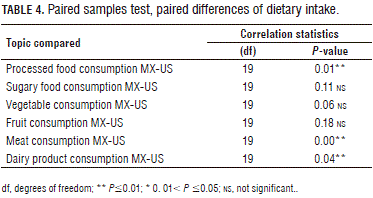
In the case of vegetable consumption, no variation of intake was found, while the consumption of fruit decreased, due not to a lack of resources to purchase them, but because the populations had more access to resources they preferred, i.e. buying fast food, processed food and others instead of what they were used to. This result is different to that found in Latino immigrant populations in the state of Washington by Neuhouser et al. (2004) and can be related to differences in income and education of the immigrants in each of these states.
The differences reported in the consumption of meat and dairy products are often due to increased consumption in the United States since participants reported a higher income and, thus, a greater purchasing power to obtain them. This situation was reported by Gilbert and Khokhar (2008) for some ethnic groups, who maintained cultural food habits despite expensive imported foods that are purchased despite their cost relative to income. In the case of Mexican Latino immigrants in Frankfort, we found that the consumption of typical and traditional food still exists, but it has been replaced by a new dietary pattern in the host country.
The Body Mass Index (BMI) is defined by the World Health Organization (2015) as a simple index of weight to height that is commonly used to classify overweight and obese adults. It is defined as a person's weight in kilograms divided by the square of his/her height in meters (kg m2), and a BMI greater than or equal to 25 is overweight; a BMI greater than or equal to 30 is obese.
According to the results, 45% of the participants were overweight and another 45% were obese; only 10% of the participants were in a normal weight range; this is perhaps related to a decrease in physical activity in the US, as seen in the results of the paired T-test for physical activity MX-US. t (19) = 0.00 P≤0.01, which showed statistically significant results basically because, in the US, the participants owned cars and, therefore, walked very little and did not perform any physical activity, while, in México, they walked more and were more active. This data can be linked to the fact that 33.2% of Hispanic adults in the state of Indiana are reported as being overweight (CDC, 2014).
Perception of change in living conditions and food habits
Each participant was asked about his/her satisfaction level with their living and eating habits in Mexico and the US on a scale of 1-7, where 1 is extremely dissatisfied and 7 extremely satisfied, both aspects obtained statistically significant differences.
The perception the of living conditions for all of the participants improved by living in the US. In general, rising incomes and, thus, purchasing power, for this aspect of perceptions of change, had results that the paired t test revealed as having statistically significant differences for the satisfaction grade for the living conditions of the participants (Tab. 5), meaning that they achieved their goal of improving their quality of life by coming to the United States.
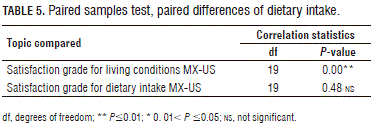
Regarding eating habits, the participants reported that they had enough money to eat any kind of food, but they were aware that they did not eat adequately.
Some direct quotes from the participants follow:
"... The thing is... you know... the food here is really bad for your health but it is very tasty. Then, I cannot say 2 because it means very unsatisfied and I will be lying to you. Right after finishing this interview I will go straight to Burger King" (Participant # 2).
"... Also, here I drink more than 6-7 cans of soda per day and in Mexico just 2..." (Participant # 8).
"... The food is not very good here; lots of fast food and most of the canned food are not as natural as the food we used to eat in Mexico..." (Participant # 6).
"... Sometimes people will give you clothes or my mom had to sew or mend them, putting patches, sometimes we did not have enough food for us to eat and my mom did not eat and gave us her food..." (Participant #1).
"... Here, I feel safe, I feel really happy; not in Mexico, there is not security. There, many children are disappearing and other things are happening too. I would say that here is a better place for my children..." (Participant # 12).
Conclusions
The perception of changes in the living conditions of the participants showed statistically significant differences, with a better quality of life in the US, specifically, in housing, utilities, and education.
The studied sample perceived a change in their dietary intake and a lower frequency of consumption of typical food from their country of origin, substituting with an increase in the consumption of fast food, processed food, and sodas in the host country.
Ninety percentage of the participants had some degree of being overweight or obese; this was perhaps related to a decrease in physical activity in the US. This showed statistically significant results basically because, in the US, the participants owned cars, while, in Mexico, the participants walked more and performed physical activity.
This study was designed as a pilot type in order to undertake programs of awareness about the eating habits of our community and the impact of our perspectives of the conditions we live in. These results were based on a small sample. It is important to conduct further studies on the issues investigated here in a representative sample of the population in Frankfort, especially because of the high percentage of Latino populations in the United States. For example, the state of Indiana is considered one of the 18 states that have a 33.2% prevalence of obesity within the Latino population. Likewise, other changes that occur with other Latino immigrants in the host country should be assessed.
Acknowledgement
The authors thank Claudia Houchen and Melinda Grismer for guidance during the study and the Community Purdue Extension Learning Network of Clinton County for allowing us to conduct this study. This study received financial support provided to the first author by the Programa Nacional de Semilleros de Investigación, Creación e Innovación by the Universidad Nacional de Colombia 2013-2015, and was developed in the Undergraduate Research Experience Purdue-Colombia (UREP-C).
Literature cited
Braun, V. and V. Clarke. 2006. Using thematic analysis in psychology. Qual. Res. Psychol. 3, 77-101. Doi: 10.1191/1478088706qp063oa [ Links ]
CDC, Center for Disease Control and Prevention. 2010. Sodium fact sheet. Atlanta, GA. [ Links ]
CDC, Center for Decease Control and Prevention. 2014. Prevalence of self-reported obesity among hispanic adults by state, BRFSS, 2011-2013. Atlanta, GA. [ Links ]
Clinton County Chamber of Commerce. 2015. Local industries. Frankfort, IN. [ Links ]
Domínguez E., A. and A. Polo V. 2008. Caracterización psicológica de los migrantes potenciales considerando aspectos de apoyo social, autoeficacia y autocontrol. pp. 427-432. In: La psicología social en México. Vol. 12. Asociación Mexicana de Psicología Social (AMEPSO), Leon, Mexico. [ Links ]
Ennis, S.R., M. Ríos-Vargas, and N.G. Albert. 2011. The hispanic population: 2010. C201OBR-04. United States Census Bureau, Washington, DC. [ Links ]
FAO. 2009. Medición multidimensional de la pobreza en México. Mexico DF. [ Links ]
FAO. 2013. Panorama de la seguridad alimentaria y nutricional en América Latina y el Caribe 2013. Santiago. [ Links ]
French, S.A., M. Story, and R.W. Jeffery. 2001. Environmental influences on eating and physical activity. Ann. Rev. Public Health 22, 309-335. Doi: 10.1146/annurev.publhealth.22.1.309 [ Links ]
FRAC, Food Research and Action Center. 2010. Disparities in food insecurity. Washington, DC. [ Links ]
Gadd, M., J. Sundquist, S.-E. Johansson, and P. Wändell. 2005. Do immigrants have an increased prevalence of unhealthy behaviors and risk factors for coronary heart disease? Eur. J. Prev. Cardiol. 12, 535-541. Doi: 10.1097/01.hjr.0000174829.25388.ed [ Links ]
Gilbert, P.A. and S. Khokhar. 2008. Changing dietary habits of ethnic groups in Europe and implications for health. Nutr. Rev. 66, 203-215. Doi: 10.1111/j.1753-4887.2008.00025.x [ Links ]
Kaplan, M.S., N. Huguet, J.T. Newsom, and B.H. McFarland. 2004. The association between length of residence and obesity among Hispanic immigrants. Amer. J. Prev. Med. 27, 323-326. Doi: 10.1016/j.amepre.2004.07.005 [ Links ]
Lafuente L., M., U. Faura M., and O. García L. 2009. Condiciones de vida y pobreza consistente. pp. 1-20. In: XVII Jornadas ASEPUMA - V Encuentro Internacional de Profesores de Matemáticas para la Economía y la Empresa. Actas 17. Burgos, Spain. [ Links ]
Marroni, M.G. 2006. Migrantes mexicanas en los escenarios familiares de las Comunidades de origen: amor, desamor y dolor. Estudios Sociológicos 24, 667-669. [ Links ]
MPI, Migration Policy Institute. 2015. Frequently requested statistics on immigrants and immigration in the United States. Washington, DC. [ Links ]
Neuhouser, M.L., B. Thompson, G.D. Coronado, and C.C. Solomon. 2004. Higher fat intake and lower fruit and vegetables intakes are associated with greater acculturation among mexicans living in Washington State. J. Am. Diet. Assoc. 104, 51-57. Doi: 10.1016/j.jada.2003.10.015 [ Links ]
Ordoríca, M. and J.-F. Prud'Homme. 2012. Los grandes problemas de México. El Colegio de México, Mexico DF. [ Links ]
Palomba, R. 2002. Calidad de vida: conceptos y medidas. CEPAL; CELADE, Santiago. [ Links ]
Rojas R., T. 2012. Bienestar social de las familias agrícolas migrantes: acciones gubernamentales y de las empresas agroexportadoras. Iberofórum 7, 35-71. [ Links ]
Salas L., M.L., C. Recéndez G., and M.A. Salas L. 2011. Migración internacional y feminización de la producción. El caso de Atitanac y La Encarnación, Villanueva, Zacatecas, México. Obs. Econ. Latinoam. 149, 1-16. [ Links ]
Sallis, J.F. and K. Glanz. 2009. Physical activity and food environments: solutions to the obesity epidemic. Milbank Q. 87, 123-154. Doi: 10.1111/j.1468-0009.2009.00550.x [ Links ]
Satia-Abouta, J., R.E. Patterson, M.L. Neuhouser, and J. Elder. 2002. Dietary acculturation: applications to nutrition research and dietetics. J. Am. Diet. Assoc. 102, 1105-1118. Doi: 10.1016/S0002-8223(02)90247-6 [ Links ]
United States Census Bureau. 2010. State and County QuickFacts. Frankfort (city), Indiana. In: http://quickfacts.census.gov/qfd/states/18/1825324.html; consulted: March 27, 2015. [ Links ]
USDHHS, United States Department of Health and Human Services. 2005. Dietary guidelines for Americans 2005. Washington, DC. [ Links ]
Vera N., J.A. and J.A. Robles L. 2010. Condiciones de vida y psicosociales de ni-os migrantes en el noroeste de México. Civitas, 10, 345-365. [ Links ]
Verbeke, W. and G. Poquiviqui L. 2005. Ethnic food attitudes and behaviour among Belgians and Hispanics living in Belgium. British Food J. 107, 823-840. Doi: 10.1108/00070700510629779 [ Links ]
World Health Organization. 2015. Obesity and overweight. Fact sheet No. 311. Geneva, Switzerland. [ Links ]














